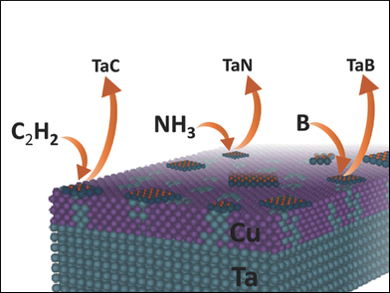Two-dimensional materials, such as graphene, are only a few atoms thick and often have properties that are substantially different from the bulk material. 2D materials have a broad range of potential applications, e.g., in catalysis, energy storage, or in coatings. Metal carbides, nitrides, and borides, for example, are particularly promising for coatings as they are hard, wear-resistant, and stable in high temperatures.
Kamanio Chattopadhyay, Indian Institute of Science, Bangalore, India, Chandra Sekhar Tiwary and Pulickel M. Ajayan, Rice University, Houston, TX, USA, and colleagues have synthesized ultrathin tantalum carbide, boride, and nitride. The team pressed together foils of copper and tantalum, two immiscible metals. Then they used chemical vapor deposition (CVD) at 1077 °C to prepare thin layers of either tantalum carbide, tantalum boride, or tantalum nitride, using C2H2, boron powder, or ammonia as precursors (pictured).
The approach is based on the metals’ resistance to form any intermetallic phases, which causes clusters of pure tantalum to migrate through the copper foil upon heating. The researchers can control the diffusion of tantalum to the surface by varying the temperature and reaction times, which, in turn, controls the growth of the ultrathin tantalum carbides, nitrides, and borides. The synthesized atomically thin materials protect the copper matrix from oxidation and improve its scratch resistance.
- Metal Immiscibility Route to Synthesis of Ultrathin Carbides, Borides, and Nitrides,
Zixing Wang, Vidya Kochat, Prafull Pandey, Sanjay Kashyap, Soham Chattopadhyay, Atanu Samanta, Suman Sarkar, Praveena Manimunda, Xiang Zhang, Syed Asif, Abhisek K. Singh, Kamanio Chattopadhyay, Chandra Sekhar Tiwary, Pulickel M. Ajayan,
Adv. Mater. 2017.
DOI: 10.1002/adma.201700364


